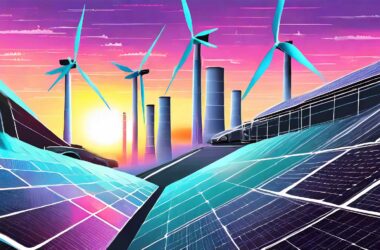Off-shore wind turbines are an important source of renewable energy, but how do they work? In this blog post, we’ll dive into the mechanics of off-shore wind turbines and explore how they generate electricity. By understanding how these machines work, we can better appreciate their role in combating climate change.
The basics of how wind turbines work
Wind turbines are an amazing invention that harnesses the power of the wind to produce clean energy.

They work by capturing the kinetic energy of the wind and converting it into rotational energy. This turns a turbine, which is connected to a generator and produces electricity. The blades are specifically designed to catch as much wind as possible while allowing it to pass through with minimal resistance. This maximized efficiency enables us to capture more energy from the same amount of winds, making it a reliable source for renewable and clean energy technologies.
The benefits of offshore wind turbines
Offshore wind turbines offer tremendous potential for a reliable, clean energy source that can help reduce overall carbon emissions and contribute to a healthier planet.
Increasing the use of offshore wind turbines means reducing our reliance on fossil fuels, minimizing air pollution, increasing job opportunities in related fields, and curbing the effects of climate change.
Researchers have already seen evidence of improved public health outcomes due to decreased air pollution from the more efficient production of electricity through offshore wind turbines. These benefits are not available from the generation of electricity from fossil fuels. The future of renewable energy lies with offshore wind turbines – let’s capitalize on this opportunity to create a better planet, now and in generations to come.
The challenges of offshore wind turbines
Offshore wind turbines are one of the most promising renewable energy sources, but they face unique challenges. Substantial investments are required up front to deploy sophisticated and expensive turbine foundations. Turbine sites must also remain stable in a marine environment, which means they must be able to withstand strong currents and tides along with harsh weather conditions such as the formation of ice and powerful waves. The turbulence created by uneven air flow can also negatively affect the output efficiency, making it difficult for the turbines to generate consistent power.
Critically, careful consideration is needed when planning for offshore wind farms and considerable expertise is necessary for the successful operation of turbine units.
How offshore wind turbines are changing the energy landscape
Offshore wind turbines are revolutionizing the energy landscape, allowing more efficient and practical production of electricity than ever before. They provide an inexhaustible source of clean, renewable power and employ cutting-edge technology to turn wind into electricity without releasing emissions into the air or water. Not only are they changing the way we generate energy, they’re also fundamentally transforming our relationship with the environment by reducing our dependence on fossil fuels such as coal and gas. The growth of offshore wind turbines is creating jobs in regions around the world and advancing energy research capabilities, paving the way for a cleaner, greener future.
The potential for offshore wind turbines is clear. They offer a number of advantages over onshore turbines, including higher capacity factors, stronger and more consistent winds, less visual pollution, and no land-use conflicts. The challenges associated with offshore development are significant but manageable, and the sector is already making progress in addressing them. As the costs of offshore wind continue to fall and public support remains strong, we can expect to see even more growth in this exciting area of renewable energy.








